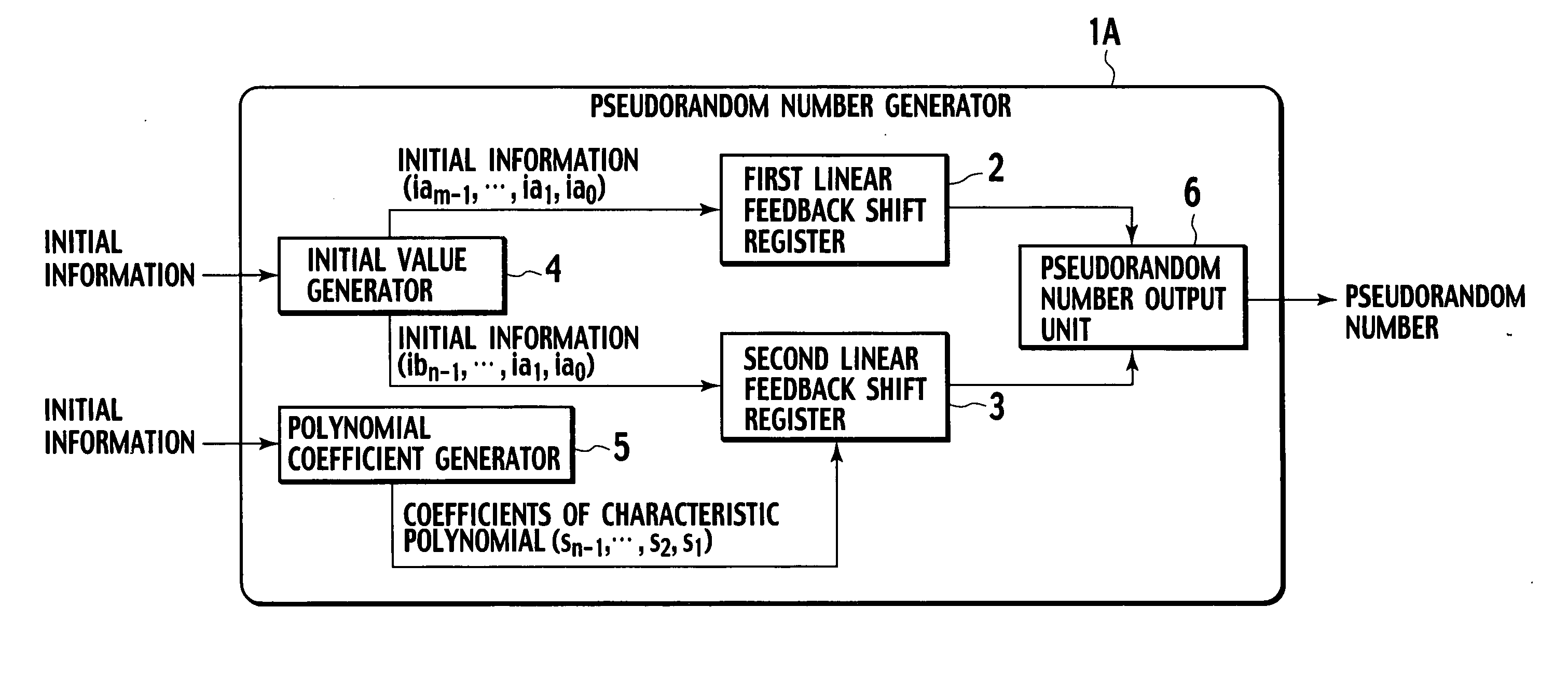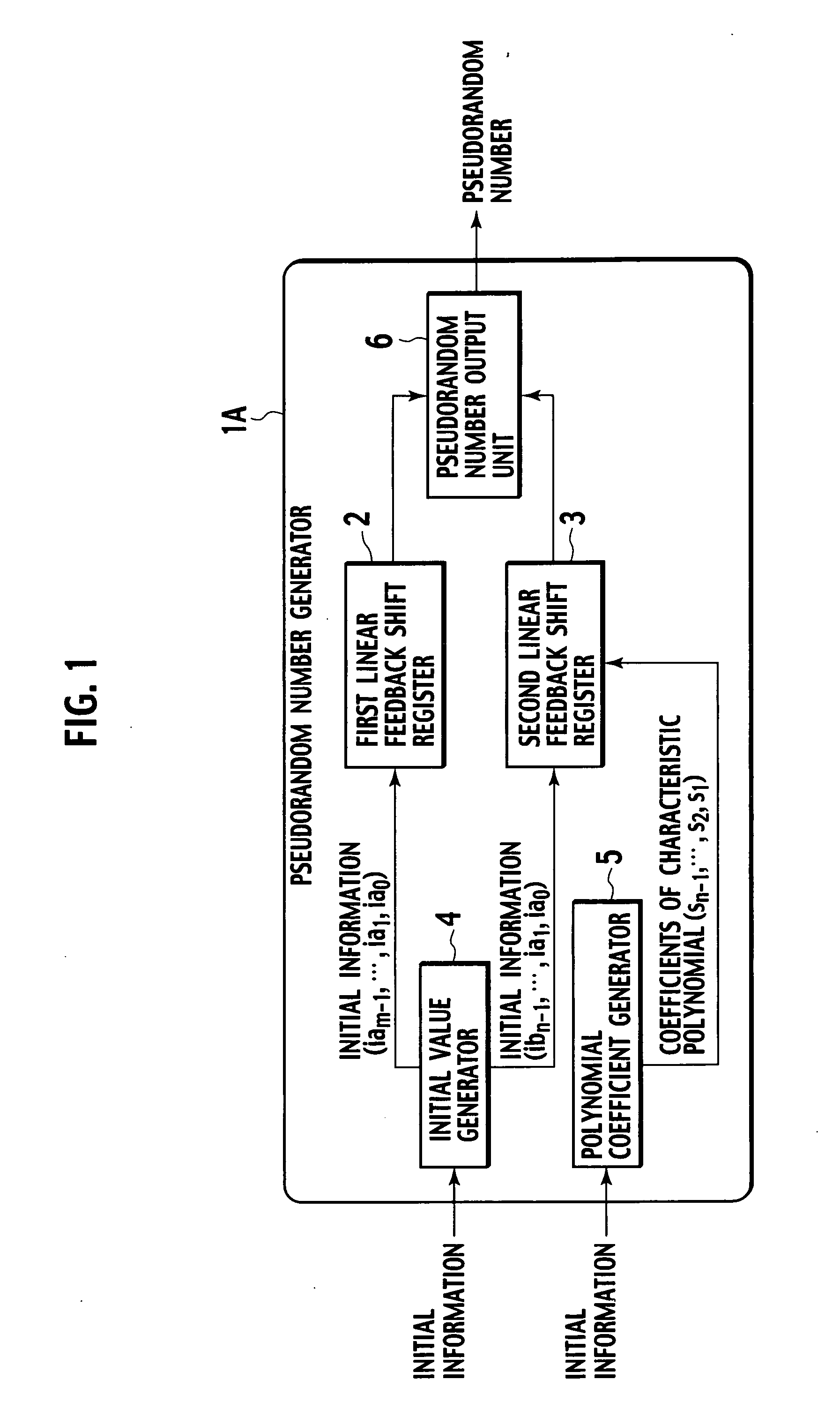Pseudorandom number generator and pseudorandom number generation program
a pseudorandom number and generator technology, applied in the field of pseudorandom number generator and pseudorandom number generation program, can solve the problems of difficult to predict the sequence of pseudorandom numbers to be generated, decrypt or tamper with data,
- Summary
- Abstract
- Description
- Claims
- Application Information
AI Technical Summary
Benefits of technology
Problems solved by technology
Method used
Image
Examples
first embodiment
[0022] In FIG. 1, a pseudorandom number generator 1A according to the first embodiment has a first linear feedback shift register 2, a second linear feedback shift register 3, an initial value generator 4, a polynomial coefficient generator 5, and a pseudorandom number output unit 6.
[0023] The first linear feedback shift register 2 is an m-step linear feedback shift register having m flip-flop circuits (to be explained later in detail). The second linear feedback shift register 3 is an n-step linear feedback shift register having n flip-flop circuits (to be explained later in detail).
[0024] The initial value generator 4 has functions of using initial information to be provided externally or using predetermined conditions that may be obtained from always changing information such as date and time information or from physical phenomena such as heat, noise, and the like, generating initial values ia (iam−1, iam−2, . . . , ia1, ia0) accordingly for the flip-flops of the first linear f...
second embodiment
[0044] In FIG. 6, a pseudorandom number generator 1B according to the second embodiment has a first linear feedback shift register 2, a second linear feedback shift register 3, an initial value generator 4, a polynomial coefficient generator 5, a pseudorandom number output unit 6, a primitive polynomial selector 7, and a primitive polynomial memory 8. The same parts as those of the first embodiment are represented with the same numerals and their detailed explanations are omitted.
[0045] The primitive polynomial selector 7 has functions of referring to externally provided initial information, selecting one of primitive polynomials stored in the primitive polynomial memory 8 accordingly, and supplying coefficients a (am−1, . . . , a1) of the primitive polynomial serving as a characteristic polynomial to the first linear feedback shift register 2.
[0046] The primitive polynomial memory 8 stores a plurality of primitive polynomials with identification information, for setting AND circu...
third embodiment
[0053] The third embodiment employs two pseudorandom number generators 1C. For example, one pseudorandom number generator 1 is arranged on a transmission side and the other pseudorandom number generator 1 is arranged on a receive side. The pseudorandom number generators 1C share characteristic polynomial coefficients and initial values (initial data), to generate the same pseudorandom number.
[0054] In FIG. 8, the pseudorandom number generator 1C according to the third embodiment has a first linear feedback shift register 2, a second linear feedback shift register 3, an initial value generator 4, a polynomial coefficient generator 5, a pseudorandom number output unit 6, a primitive polynomial selector 7, a primitive polynomial memory 8, and a communication unit 9. The same parts as those of the first and second embodiments are represented with the same numerals and their detailed explanations are omitted. For the sake of convenience, each component of the pseudorandom number generat...
PUM
 Login to View More
Login to View More Abstract
Description
Claims
Application Information
 Login to View More
Login to View More - R&D
- Intellectual Property
- Life Sciences
- Materials
- Tech Scout
- Unparalleled Data Quality
- Higher Quality Content
- 60% Fewer Hallucinations
Browse by: Latest US Patents, China's latest patents, Technical Efficacy Thesaurus, Application Domain, Technology Topic, Popular Technical Reports.
© 2025 PatSnap. All rights reserved.Legal|Privacy policy|Modern Slavery Act Transparency Statement|Sitemap|About US| Contact US: help@patsnap.com



